Showing top 0 results 0 results found
Showing top 0 results 0 results found

What you’ll learn from this article:
Key findings:
Digital marketing agency pricing varies based on services, scope, and value.
Digital marketing company pricing varies widely depending on the services provided, marketing campaign goals, and level of expertise. Costs can range from $500 to over $20,000 per month based on scope, deliverables, and expected ROI.
Choosing the right digital marketing company requires aligning business goals with expertise and transparency.
Choosing the right digital marketing agency means finding one that understands your specific business goals and offers services aligned with those objectives. It’s essential to prioritize agencies that provide custom strategies, clear communication, and transparent reporting to ensure long-term success.

Many businesses turn to digital marketing agencies to help them reach more customers, improve their online business presence, and generate sales. Agencies offer access to specialized knowledge, tools, and proven strategies that can be difficult or expensive to build internally. Whether the goal is to increase website traffic, improve search rankings, or launch paid advertising campaigns, agencies are often brought in to deliver results quickly and efficiently.
However, deciding which agency to hire isn’t always straightforward. Business owners and marketing teams often ask the same questions: What services should a digital marketing agency offer? How much should I expect to pay? Which agency is actually the best for what I need?
This article will walk through what a digital marketing agency is, the services they typically provide, how much they charge, and how to choose the one that fits your business. You’ll come away with a clear understanding of how agency pricing works, which services are worth investing in, and how to identify a partner that can help you reach your marketing goals. Whether you’re just starting your search or narrowing down options, this guide will help you make a confident and informed decision.
📚 Would you like to start your own agency? Check out tips and latest trends!
What is an ecommerce marketing or digital commerce agency
Ecommerce plays a central role in modern digital marketing, especially for brands that rely on online stores as their primary sales channel. In this context, ecommerce marketing refers to the tailored strategies and tools used to attract visitors, convert them into customers, and increase the lifetime value of those customers through digital channels such as paid ads, email campaigns, and organic search.
| Feature / focus area | Ecommerce marketing agency | Digital commerce agency |
|---|---|---|
| Primary goal | Drive product sales through digital campaigns | Optimize the entire digital buying experience |
| Key focus | Traffic generation, conversions, ROAS | Customer journey, UX, personalization, and platform integration |
| Typical services | Paid ads (Google, Meta), SEO services, email marketing, retargeting | UX/UI design, content strategy, platform development, omnichannel retail |
| Performance metrics | Return on ad spend (ROAS), CAC, conversion rates | Engagement, retention, cross-channel performance, CLV |
| Client type | DTC brands, online retailers, startups | Enterprise retailers, omnichannel brands, B2C/B2B commerce platforms |
| Tech stack | Ad platforms, email tools, analytics dashboards | CMS, ecommerce platforms (Shopify, Magento), CRM, PIM, personalization engines |
| Project approach | Campaign-based, short to mid-term strategy | End-to-end digital strategy, long-term infrastructure and growth |
| Best for | Businesses focused on scaling product sales quickly | Brands needing cohesive, scalable digital commerce ecosystems |
An ecommerce marketing agency is a specialized type of digital agency that focuses specifically on helping online retailers grow. These agencies are equipped to manage everything from product feed optimization and abandoned cart recovery to Google Shopping ads, retargeting, and personalized email flows. Their goal is to increase product visibility, improve conversion rates, and drive more revenue through data-driven campaigns tailored to ecommerce businesses.
A digital commerce agency, on the other hand, takes a broader and more strategic approach. While ecommerce marketing agencies focus mainly on generating and converting traffic, digital commerce agencies are involved in the full customer journey. This includes areas such as website design and user experience, mobile responsiveness, content strategy, personalized recommendations, omnichannel integration, and backend system support. They work not only to increase sales but also to improve how people interact with your brand across devices and platforms.
The key difference between the two lies in scope. Ecommerce marketing agencies are performance-focused and campaign-driven, often measured by metrics like return on ad spend (ROAS) or customer acquisition cost (CAC). Digital commerce agencies look at the entire commerce experience, from how customers find products to how they complete their purchase and return for more.
📚 Check out 10 steps to start an advertising agency and serve unique businesses.
What services should a digital marketing agency offer
When evaluating a digital marketing agency, it’s important to understand which services are considered essential and which ones are more advanced or specialized. A reliable agency should be able to offer both foundational services that support digital visibility and optional add-ons that help scale business growth or target specific goals.
If you’re wondering, “What services should a marketing agency offer?” or “What are the 7 pieces of digital marketing?” This section clearly explains the answers.
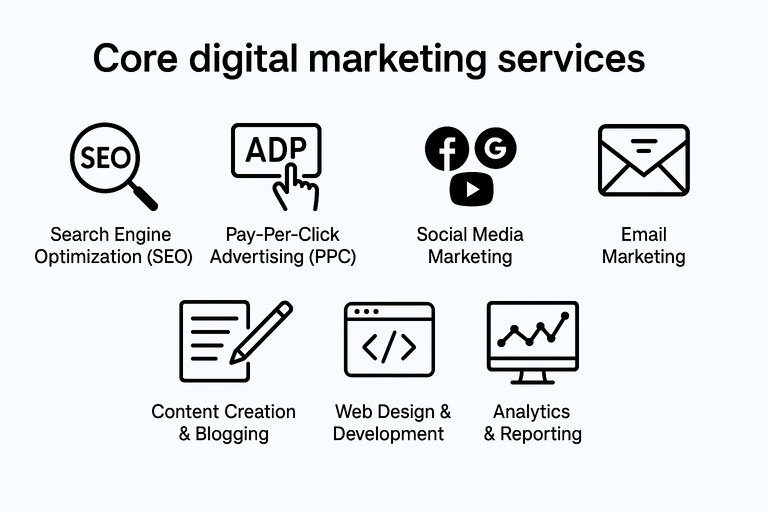
Core digital marketing services
These are the foundational services that nearly every business can benefit from, regardless of size or industry.
Search engine optimization (SEO)
SEO efforts help improve your visibility in organic search results. Agencies should offer technical SEO audits, on-page optimization, link building, and keyword rankings strategy to drive long-term traffic from search engines like Google.
Use our net profit margin calculator to evaluate how this model can work for you.
📚 See SEO mistakes to avoid while crafting a marketing strategy.
Pay-per-click advertising (PPC)
PPC campaigns involve strategic thinking in running paid ads on platforms like Google Ads, Meta, or LinkedIn. A good agency will manage bidding, targeting, ad copy, and A/B testing to generate quick, measurable results.
Social media marketing
This includes content planning, posting, community management, and paid social campaigns. It’s essential for brand visibility, audience engagement, and customer loyalty.
Email marketing
Agencies should offer a comprehensive suite of email list segmentation, automation workflows, campaign design, and analytics. When done right, email remains one of the highest-ROI digital channels.
Content creation and blogging
Content fuels all other marketing efforts. Agencies should offer unique business copywriting, blog creation, infographics, and possibly video or interactive content that aligns with SEO latest trends and social strategies.
Web design and development
Your website is often the first point of contact with customers. Digital marketing experts should be able to create mobile-friendly, fast-loading, user-centered websites, often on platforms like WordPress, Shopify, or Webflow.
📚 See tips on how to increase traffic on your Magento website!
Analytics and reporting
Without actionable insights, marketing has no direction. Agencies must offer regular performance reports, campaign insights, and tracking setup (Google Analytics, GA4, conversion goals, and more key tools) to evaluate what’s working.
Conversion rate optimization (CRO)
CRO focuses on improving the number of website visitors who convert into leads or customers. Agencies may use A/B testing, heatmaps, and user behavior analysis to optimize pages and ensure business success.
Advanced or specialized digital marketing services
These are valuable for companies looking to optimize their performance or expand into more competitive markets.
Marketing automation
Helps streamline workflows across email, CRM, chatbots, and ad platforms. This is especially important for B2B or lead-nurturing strategies.
Influencer and affiliate marketing
Some agencies offer influencer outreach, affiliate program setup, and partner management, especially for ecommerce or lifestyle brands.
Video marketing and production
As video content dominates online platforms, agencies may offer scripting, editing, and platform-specific optimization (like YouTube SEO).
Reputation management
Managing reviews, brand mentions, and online sentiment is increasingly important, especially in industries like hospitality, health, and finance.
Final thought
At a minimum, a digital marketing agency should be able to help you attract traffic, engage your audience, and convert visitors into customers. The more advanced their capabilities, the better they can support your ecommerce business as it grows. Understanding both the core and optional services an agency offers will help you determine whether they’re the right fit for your current goals and future plans.
📚 Are you an agency? See our tips on how to boost your clients’ conversions.
Looking for a beneficial partnership?
Join our Solution Program to unlock a new revenue stream and stand out from the competition.
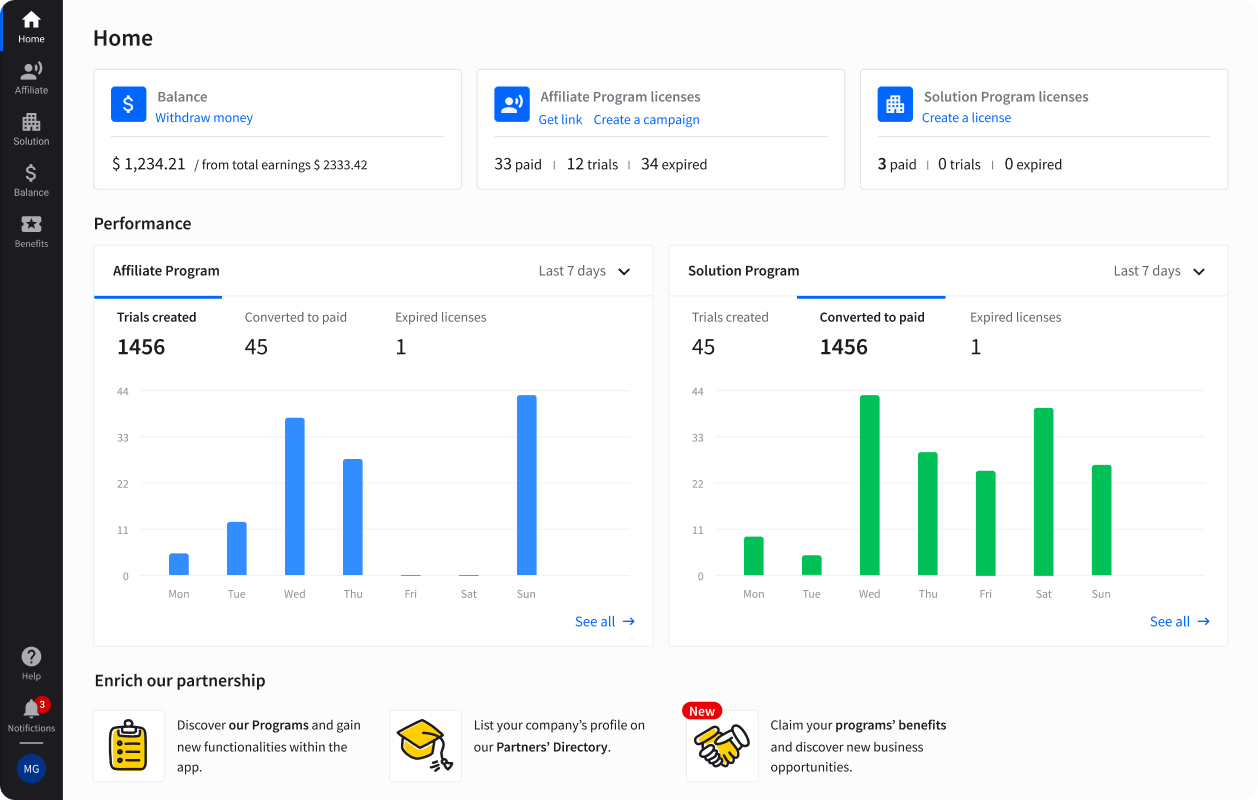
How much should you pay a digital marketing agency in 2025
If you’re wondering "How much should I pay a digital marketing agency?" or searching for "average fees for digital marketing services", the answer depends on a range of factors. Pricing can vary significantly based on the agency’s structure, the services you need, and the scale of your campaigns.
There is no one-size-fits-all cost, but understanding the pricing models and what influences rates will help you make a more informed and realistic decision.
📚 Want to know more about running a successful agency? See our guide and learn some tips!
Common pricing models
Many marketing agencies typically use one or a combination of the following billing structures:
Hourly rate
Some agencies charge by the hour, usually between $75 and $200+ per hour, depending on the agency’s expertise and the task complexity. This model is common for consulting, audits, or small projects of increasing online visibility.
Monthly retainer
The most common pricing model for ongoing services is a fixed monthly fee. Retainers often range from $2,000 to $10,000+ per month and cover local SEO, content marketing, social media management, and analytics as a bundled service.
Project-based pricing
Project-based pricing is used for website builds, branding packages, or short-term campaigns. Projects can range from $3,000 to $50,000+, depending on deliverables and scope.
Performance-based pricing
In this model, payment is tied to results of effective marketing strategies (like cost per lead, percentage of revenue generated). While appealing, this structure is often used in limited scenarios due to the complexity of attributing results.
Key factors that influence cost
Several variables can affect how much a digital marketing agency will charge for boosting brand visibility:
-
Agency size and experience: Established agencies with a proven track record often charge more than newer local businesses or boutique firms.
-
Scope and duration: Multi-channel marketing strategies over a 12-month period will naturally cost more than a 3-month SEO campaign.
-
Industry complexity: Highly competitive or regulated industries (like finance, health, or law) may require more expertise and carry higher price tags to ensure sustainable growth.
-
Tech stack and tools: Use of premium tools for automation, analytics, personalization, or A/B testing can increase monthly costs.
Cost by service type (typical monthly ranges in 2025)
| Service | Low-end (in USD) | High-end (in USD) |
|---|---|---|
| SEO | 500 | 5,000+ |
| PPC management | 1,000 | 10,000+ |
| Social media management | 750 | 6,000+ |
| Email marketing | 500 | 4,000+ |
| Content marketing / blogging | 1,000 | 8,000+ |
| Conversion rate optimization (CRO) | 1,500 | 10,000+ |
| Web design and development | 3,000 (project) | 50,000+ |
| Full-service retainer | 2,000 | 20,000+ |
So how much should you pay? The answer depends on your goals, budget, and growth stage. A startup may begin with a narrow focus on SEO or paid digital advertising at a lower cost, while a scaling ecommerce brand might need a multi-service retainer in the mid to high five-figure range. The best investment is one that delivers measurable ROI, not just the lowest price.
Who are the best digital marketing agencies in 2025
With thousands of digital marketing agencies competing for attention, businesses often look for trusted recommendations and verified partners. While the “best” agency depends on your business objectives, budget, and industry, some agencies consistently stand out for their results, service quality, and proven expertise.
Below are five standout Text-Certified Agencies recognized for their performance and innovation across a wide range of industries by a global leader in customer communication and support technologies. These digital marketing agencies are known not just for driving growth but for delivering customer service excellence that increases retention and maximizes ROI for client businesses.
📚 Interested in Text? See how 91% of Systell customers improve ROI thanks to implementing one of Text’s products, LiveChat!
| Agency | Best for | Core focus | Key strengths |
|---|---|---|---|
| WebitMD | Startups, SMBs, tech, growth-stage brands | Full-funnel growth marketing | SEO, paid media, automation, sales enablement |
| Conscious Commerce Corporation (CCC) | Mid-market, nonprofits, education sector | Integrated digital strategy and development | SEO, email marketing, web design, CRM integration |
| Phillip Batt International | Enterprises, BPO buyers, international ops | BPO and digital support services | Global scale, multilingual support, ecommerce integration |
| LiveSalesman | Ecommerce brands, global online retailers | Multilingual live chat and ecommerce support | 30+ languages, customer acquisition via chat, cultural fluency |
| LiveChat Service | Local and EU-based B2C, service-based firms | Real-time chat engagement and lead generation | 99% satisfaction, <30s response time, lead quality optimization |
WebitMD
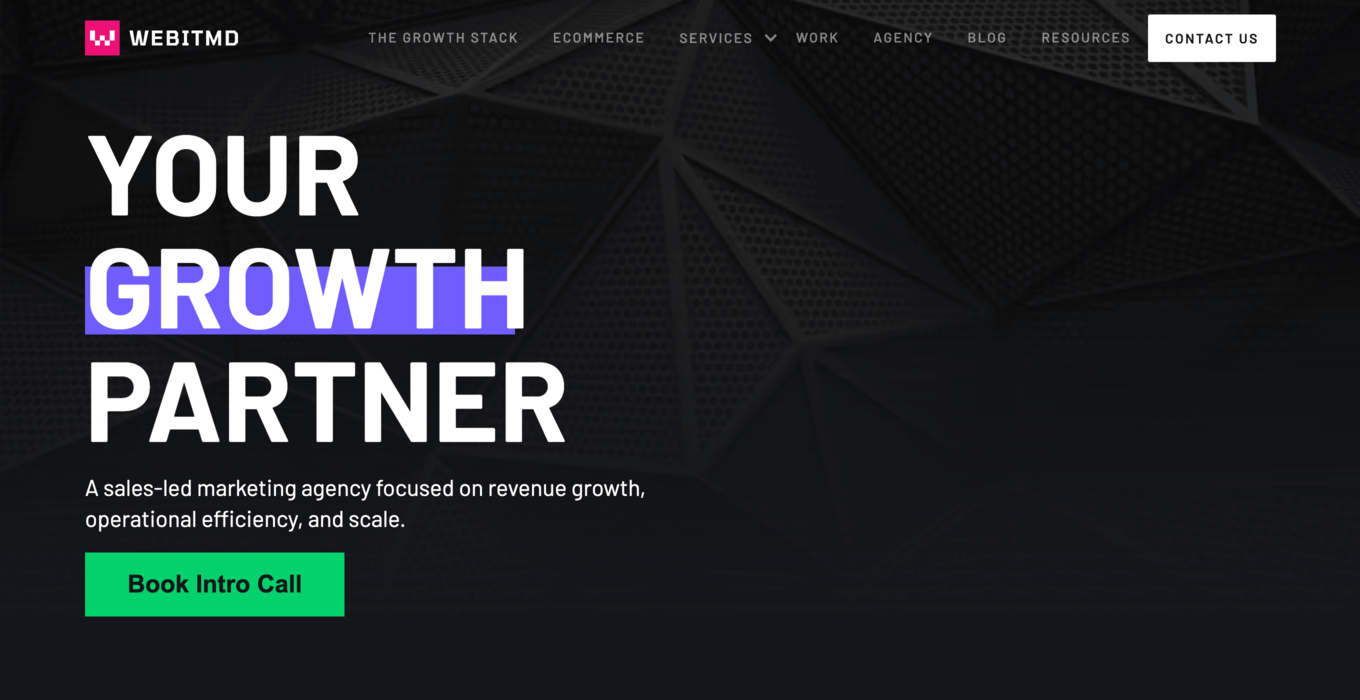
WebitMD is a boutique digital marketing and creative agency with offices in Los Angeles and New York. Since 2008, they’ve served an impressive client base that includes fast-scaling startups and Fortune 500 companies.
Known for blending growth marketing with creative execution, they specialize in full-funnel strategies—integrating SEO, paid media, sales enablement, and automation. Their reputation for agile execution and personalized service has made them a top choice for companies seeking scalable marketing systems and clear ROI.
👉Check WebitMD Text Partner Directory page.
Conscious Commerce Corporation (CCC)
📚 See how CCC made a $50,000 deal through LiveChat and increased website sales by 379%!
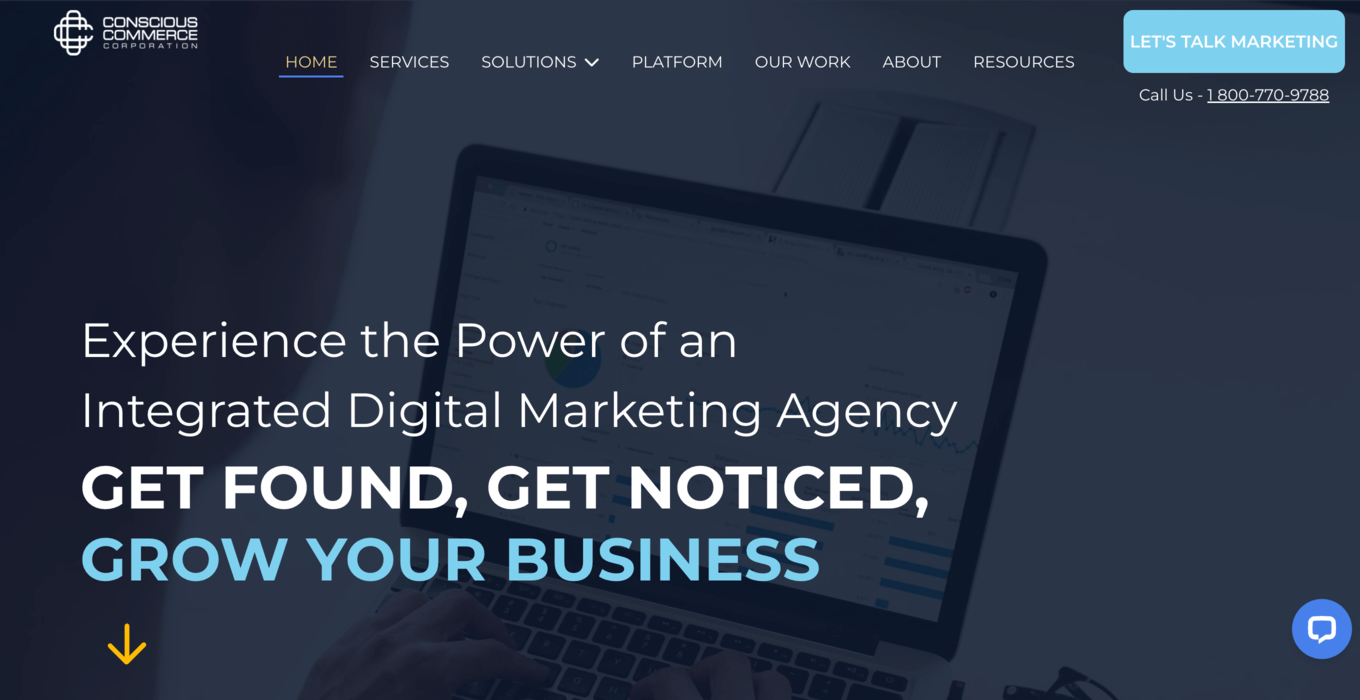
Based in Canada, Conscious Commerce Corporation has been delivering digital marketing services since 2004 and has worked with more than 400 clients. Their offerings span SEO, email marketing, ecommerce strategy, and custom web development.
What sets CCC apart is their commitment to data-driven growth and customer experience design, particularly for nonprofit, education, and mid-market clients. With multiple awards and long-standing client relationships, they’re known for combining technology integration with high-touch digital strategy.
👉Check Conscious Commerce Corporation Text Partner Directory page.
Phillip Batt International
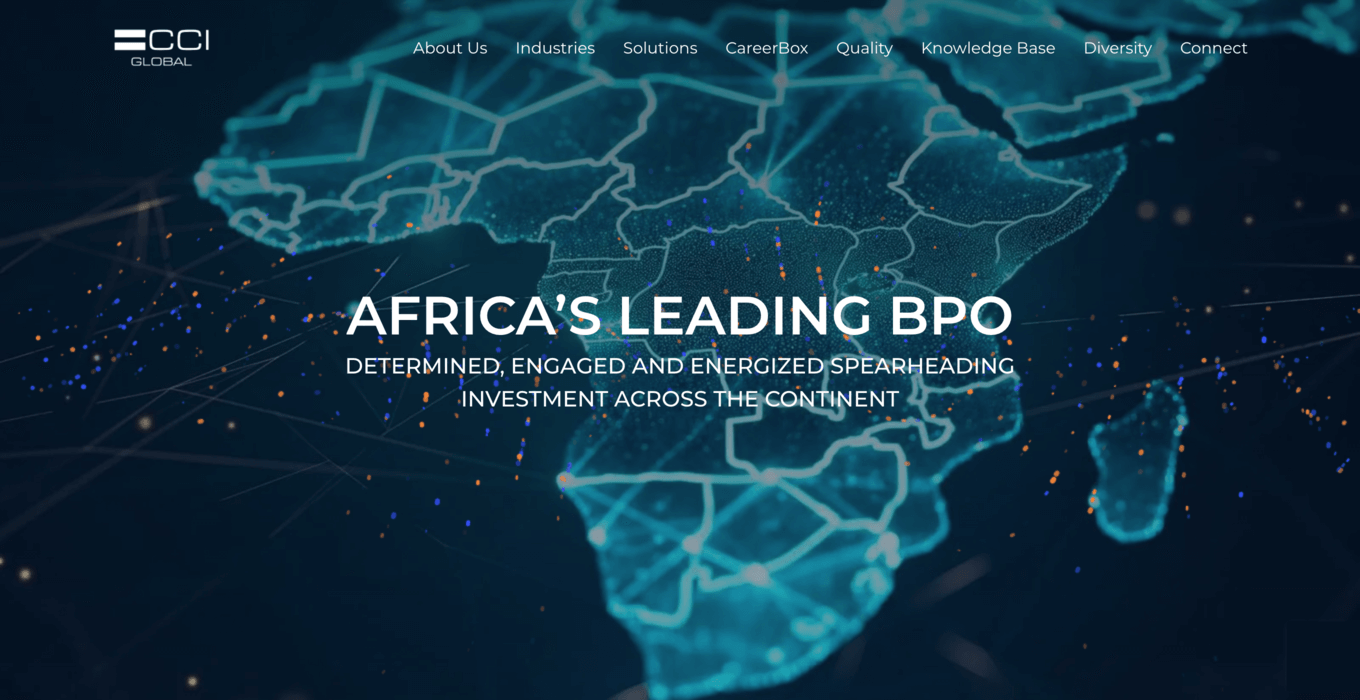
Phillip Batt International is a global business process outsourcing (BPO) powerhouse headquartered in South Africa. With over 7,000 customer service staff and operations across multiple continents, it supports millions of digital customer interactions each month.
Though rooted in customer support, their digital marketing services are deeply integrated into ecommerce support, lead generation, and multilingual market outreach. They are ideal for enterprise clients looking for operational scale and market penetration across regions.
👉Check Phillip Batt International Text Partner Directory page.
LiveSalesman
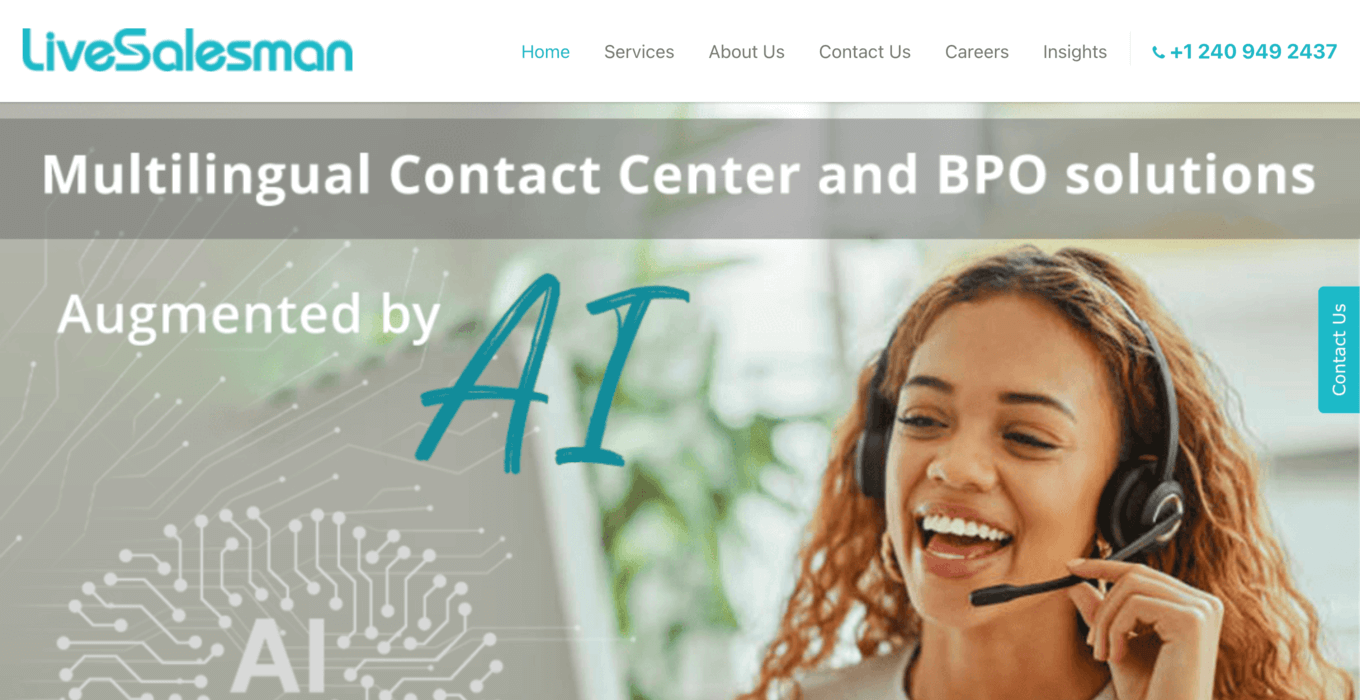
A pioneer in outsourced live-chat services, LiveSalesman has been helping businesses convert online visitors into customers for more than 15 years. Their digital marketing approach centers on multilingual, culturally adapted chat solutions for ecommerce, travel, and global brands.
With fluency in over 30 languages and deep experience in customer acquisition through chat-based funnels, LiveSalesman bridges the gap between service and sales in a way that few agencies can. It is especially valuable for international companies seeking local-market relevance without sacrificing scalability.
👉Check LiveSalesman Text Partner Directory page.
LiveChat Service
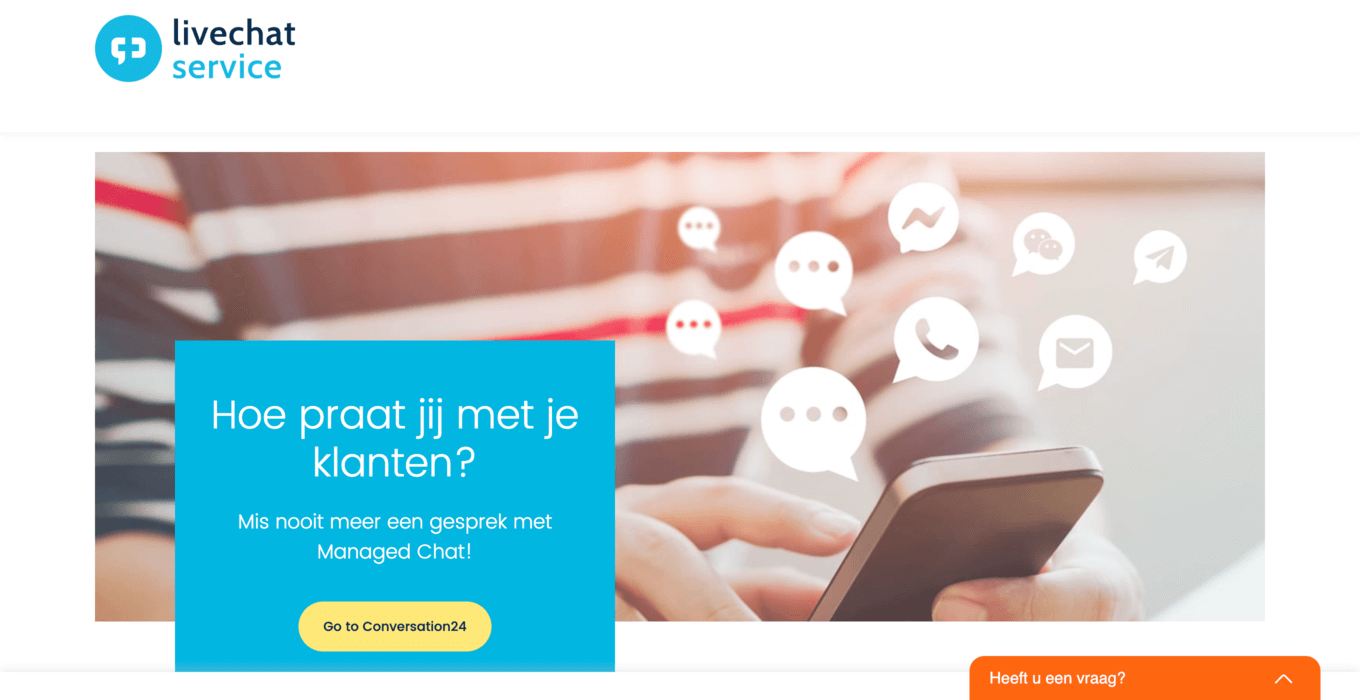
LiveChat Service, based in the Netherlands, is laser-focused on live chat optimization, lead generation, and real-time customer engagement. They’re known for their speed—delivering average first responses in under 30 seconds—and their high satisfaction scores, which exceed 99%.
While not a traditional full-service agency, their specialized focus on chat-based conversion makes them a go-to partner for businesses aiming to improve lead quality and customer service outcomes in real time.
👉 Check LiveChat Service Text Partner Directory page.
Summary
These five agencies represent a diverse range of strengths: from full-service marketing execution and digital marketing strategy to customer service outsourcing and real-time conversion optimization. Whether you’re looking to launch a cross-channel campaign, optimize your online store, or improve customer interactions, these Text-Certified Partners offer a high standard of reliability and performance.
👉 Check more certified Text Partners that can help you with digital marketing solutions.
How to choose the right agency for you (at the right price)
Choosing a digital marketing agency isn’t just about finding the lowest price or the flashiest portfolio. The best agency for your business is the one that clearly understands your goals, has the expertise to deliver measurable results with trusted digital marketing efforts, and offers a partnership built on strategy, transparency, and trust.
Here’s how to evaluate agencies effectively so you can choose one that fits your objectives and your budget.
Define your goals before you search
Start by clearly understanding what success looks like. Are you trying to generate more leads, increase ecommerce sales, improve search engine optimization, or launch a new brand?
Agencies may have strengths in different areas, such as SEO, digital advertising, or ecommerce funnels, so being specific about your goals helps you filter digital marketing strategy options.
If you’re not clear on your key performance indicators (like return on ad spend, cost per lead, organic traffic growth), it’s easy to get sold on services that aren’t tied to outcomes you care about.
📚 See how to develop your own customer profile and learn which marketing services you need.
Evaluate proposals for strategy and transparency
A quality agency proposal should clearly explain how its strategy supports your business goals and can ensure sustainable growth. Look for:
-
Defined campaign objectives and timelines
-
Details on tactics (not just vague promises)
-
How results will be tracked and reported
-
A list of tools or platforms they use
Avoid agencies that focus solely on vanity metrics like “likes” or “impressions.” Instead, prioritize those that align their approach with business-level outcomes and offer full transparency on pricing, performance, and communication.
📚 See how a social media agency focused on building online communities, SoMe Connect, succeeded with Text.
Ask about team structure and client retention
Who will actually be managing your account? A senior strategist or a junior account coordinator? Understanding team structure is essential because even the best pitch can fall flat without execution.
Also ask about client retention. Agencies with long-term client relationships usually deliver consistent value and have smoother internal processes. A high churn rate may indicate missed expectations or poor communication.
Look for relevant experience and case studies
Review the agency’s past work, specifically for businesses in your industry, of a similar size, or with similar goals. A strong agency will have documented success stories, including metrics and client testimonials.
If you’re in an ecommerce business, look for digital presence expertise in platforms like Shopify, Magento, or Amazon Ads. If you’re a service business, see if they’ve driven qualified leads through SEO, PPC, or local search.
The more closely their experience matches your situation, the shorter the ramp-up period and the higher the chance of success.
Compare pricing, but focus on value and ROI
It’s natural to compare quotes, but remember: the cheapest option isn’t always the best, and the most expensive isn’t always the most strategic.
Instead of focusing solely on cost, assess what’s included for the price. Does the retainer include strategy, execution, reporting, and regular optimization? What tools or platforms are covered? Are results guaranteed or incentivized?
Ultimately, you’re not just paying for tasks; you’re investing in growth and an enhanced sales funnel. The right agency will demonstrate how its efforts relate to revenue, conversions, or customer lifetime value.
💡 Tip: Think of agency selection as a long-term relationship, not a quick transaction. A good agency will function as an extension of your team, not just a vendor. Take time to ask the hard questions, trust your instincts, and prioritize alignment over pricing alone.
Looking for a beneficial partnership?
Join our Solution Program to unlock a new revenue stream and stand out from the competition.

Conclusion
When it comes to hiring a digital marketing agency, price matters, but it shouldn’t be the only thing that guides your decision. The right agency is rarely the cheapest. It’s the one that drives real, measurable results. Whether that means generating qualified leads, improving your return on ad campaigns spend, increasing customer lifetime value, or boosting ecommerce conversions and enhancing brand visibility, the agency you choose should directly support the business outcomes you care about most.
A well-priced service that doesn’t perform is still too expensive. On the other hand, an agency that costs more but consistently increases your revenue, strengthens your brand, and uncovers online sales and growth opportunities will deliver long-term value that far exceeds the initial investment.
Before you sign with anyone, take the time to do your homework. Research agencies thoroughly, ask detailed questions, and demand clarity on agency pricing, strategy, and expected results. Look for transparency, not fluff. Find partners, not vendors. And most importantly, make sure they understand your goals and have a plan to help you reach them.
Frequently Asked Questions
-
What services should a marketing agency offer?
A marketing agency should offer a range of services tailored to your business goals, including SEO, PPC advertising, social media marketing, email marketing, content creation, web design, conversion rate optimization, and analytics. Many agencies also provide branding, lead generation, and CRM integration. -
What is ecommerce in digital marketing?
Ecommerce in digital marketing refers to all online marketing activities aimed at promoting and selling products or services through digital channels. These include search engine optimization for product pages, email campaigns, paid ads, social media promotions, and UX optimization to support the buyer journey from click to checkout. -
What is the average fee for a digital marketing agency?
The average monthly retainer fee for a digital marketing agency ranges from $2,000 to $10,000, depending on the number of services, business size, and campaign complexity. Project-based pricing may range from $5,000 to $50,000+, depending on deliverables. -
How much should you pay for digital marketing?
A good rule of thumb is to allocate 5–15% of your revenue to marketing, with a significant portion going toward digital channels. Your spending should reflect your goals: brand recognition building, lead generation, or boosting sales, and be based on projected ROI. -
How much do digital ad agencies cost?
Digital ad agencies typically charge a monthly management fee of $1,000 to $5,000+, or a percentage of ad spend (usually 10–20%). High-budget campaigns or multi-channel efforts can cost $10,000 - $50,000+ per month.


